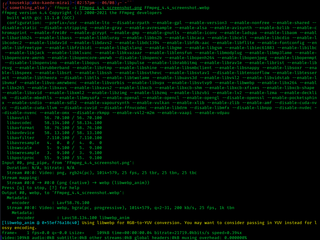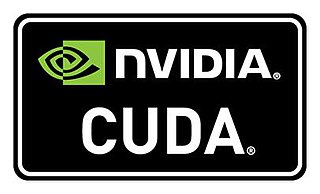
JPEG 2000 (JP2) is an image compression standard and coding system. It was developed from 1997 to 2000 by a Joint Photographic Experts Group committee chaired by Touradj Ebrahimi, with the intention of superseding their original JPEG standard, which is based on a discrete cosine transform (DCT), with a newly designed, wavelet-based method. The standardized filename extension is .jp2 for ISO/IEC 15444-1 conforming files and .jpx for the extended part-2 specifications, published as ISO/IEC 15444-2. The registered MIME types are defined in RFC 3745. For ISO/IEC 15444-1 it is image/jp2.
Theora is a free lossy video compression format. It was developed by the Xiph.Org Foundation and distributed without licensing fees alongside their other free and open media projects, including the Vorbis audio format and the Ogg container.

FFmpeg is a free and open-source software project consisting of a suite of libraries and programs for handling video, audio, and other multimedia files and streams. At its core is the command-line ffmpeg tool itself, designed for processing of video and audio files. It is widely used for format transcoding, basic editing, video scaling, video post-production effects and standards compliance.
JasPer is a computer software project to create a reference implementation of the codec specified in the JPEG-2000 Part-1 standard - started in 1997 at Image Power Inc. and at the University of British Columbia. It consists of a C library and some sample applications useful for testing the codec.
A container format or metafile is a file format that allows multiple data streams to be embedded into a single file, usually along with metadata for identifying and further detailing those streams. Notable examples of container formats include archive files and formats used for multimedia playback. Among the earliest cross-platform container formats were Distinguished Encoding Rules and the 1985 Interchange File Format.
Lossless JPEG is a 1993 addition to JPEG standard by the Joint Photographic Experts Group to enable lossless compression. However, the term may also be used to refer to all lossless compression schemes developed by the group, including JPEG 2000, JPEG-LS and JPEG XL.
OpenJPEG is an open-source library to encode and decode JPEG 2000 images. As of version 2.1 released in April 2014, it is officially conformant with the JPEG 2000 Part-1 standard. It was subsequently adopted by ImageMagick instead of JasPer in 6.8.8-2 and approved as new reference software for this standard in July 2015. OpenJPEG is a fork of libj2k, a JPEG-2000 codec library written by David Janssens during his master thesis at University of Louvain (UCLouvain) in 2001.
JPEG XR is an image compression standard for continuous tone photographic images, based on the HD Photo specifications that Microsoft originally developed and patented. It supports both lossy and lossless compression, and is the preferred image format for Ecma-388 Open XML Paper Specification documents.

Compute Unified Device Architecture (CUDA) is a proprietary parallel computing platform and application programming interface (API) that allows software to use certain types of graphics processing units (GPUs) for accelerated general-purpose processing, an approach called general-purpose computing on GPUs (GPGPU). CUDA API and its runtime: The CUDA API is an extension of the C programming language that adds the ability to specify thread-level parallelism in C and also to specify GPU device specific operations (like moving data between the CPU and the GPU). CUDA is a software layer that gives direct access to the GPU's virtual instruction set and parallel computational elements for the execution of compute kernels. In addition to drivers and runtime kernels, the CUDA platform includes compilers, libraries and developer tools to help programmers accelerate their applications.

VP8 is an open and royalty-free video compression format released by On2 Technologies in 2008.
X-Video Bitstream Acceleration (XvBA), designed by AMD Graphics for its Radeon GPU and APU, is an arbitrary extension of the X video extension (Xv) for the X Window System on Linux operating-systems. XvBA API allows video programs to offload portions of the video decoding process to the GPU video-hardware. Currently, the portions designed to be offloaded by XvBA onto the GPU are currently motion compensation (MC) and inverse discrete cosine transform (IDCT), and variable-length decoding (VLD) for MPEG-2, MPEG-4 ASP, MPEG-4 AVC (H.264), WMV3, and VC-1 encoded video.
Video Decode and Presentation API for Unix (VDPAU) is a royalty-free application programming interface (API) as well as its implementation as free and open-source library distributed under the MIT License. VDPAU is also supported by Nvidia.
Kakadu is a closed-source library to encode and decode JPEG 2000 images. It implements the ISO/IEC 15444-1 standard fully in part 1, and partly in parts 2–3. Kakadu is a trademark of NewSouth Innovations Ltd.
Intel Quick Sync Video is Intel's brand for its dedicated video encoding and decoding hardware core. Quick Sync was introduced with the Sandy Bridge CPU microarchitecture on 9 January 2011 and has been found on the die of Intel CPUs ever since.
High Efficiency Video Coding implementations and products covers the implementations and products of High Efficiency Video Coding (HEVC).
JPEG XL is a royalty-free raster-graphics file format that supports both lossy and lossless compression. It is designed to outperform existing raster formats and thus become their universal replacement.
JPEG XS is an interoperable, visually lossless, low-latency and lightweight image and video coding system used in professional applications. Applications of the standard include streaming high quality content for virtual reality, drones, autonomous vehicles using cameras, gaming, and broadcasting. It was the first ISO codec ever designed for this specific purpose. JPEG XS, built on core technology from both intoPIX and Fraunhofer IIS, is formally standardized as ISO/IEC 21122 by the Joint Photographic Experts Group with the first edition published in 2019. Although not official, the XS acronym was chosen to highlight the eXtra Small and eXtra Speed characteristics of the codec. Today, the JPEG committee is still actively working on further improvements to XS, with the second edition scheduled for publication and initial efforts being launched towards a third edition.



